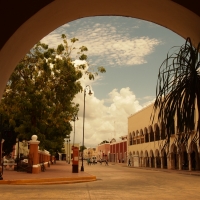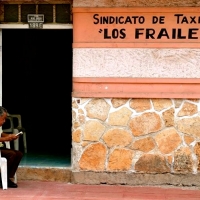About Valladolid Mexico
The city of Valladolid, named to honor the then Spanish capital of that empire, on which "the sun never sets", is located in the center of the Yucatan peninsula, 100 km from Tulum and about 160 km from Cancun. The first settlement, by the nephew of the Spanish conqueror Francisco de Montejo, dates back to 1543, although it was relocated after just two years. This was because of the inadequacy of the initial site, primarily due to the dank climate and the diseases that struck the original settlers. Because of these reasons, Valladolid was moved to the near Mayan village of Zaci, with the original buildings being dismantled, and those stones then used to build the new city. Valladolid is also known as "the heroic city", because of its involvement in two of the most important events of the history of Mexico.
The first, was here in fact, where the Caste War of Yucatan broke out in 1847, and when the native Mayan population revolted against the European descendents, who had by then, held the political and economic power in the region. It had been a long and bloody war, ending only in 1901, when the Mexican army took control over the Mayan capital, Chan Santa Cruz. Even then, several clashes continued for a further 20 years in various small villages which had refused to recognize the Mexican control over their territories.
The other important event took place in Valladolid on June 4, 1910, when insurgents, (being mainly Mayan volunteers), attacked and took control of the city, in so doing starting the first spark of the Mexican Revolution against the dictatorship of the President Porfirio Diaz. The Federal Government reacted by sending an Army battalion, which, after four days and three bloody assaults, managed to win against the resistance of the brave rebels.
The path to a new era for Mexico was eventually opened and established through many battles, and led by several predominant characters of which, among others, were Emiliano Zapata and Francisco "Pancho" Villa, and resulted in the creation and enactment of the Mexican Constitution in 1917. The Revolution officially ended in 1920.
These days, Valladolid, also known as "La capital del Oriente Maya", is a quiet city, with beautiful examples of colonial architecture, and which absolutely deserves a visit. The most important monuments are located within easy walking distance, in the historical center of the town, where the very well tended Francisco Canton Rosado Park is located. Also known as the "love park", due to the 2-seat benches facing each other, it is an ideal place to take a relaxing break under its' trees.
Around this area you can also find:
The Cathedral of San Servacio, the construction of which started in 1543, and apart from being one of the oldest churches of the "New World", is also town's most important one. The Cathedral, located right in the center of the town, was desecrated in 1703, when the "crime of the Mayors" took place actually inside the church, where a Captain Fernando Hipolito de Osorno and the attorney Pedro Gabriel Covarrubias were killed, for not taking into consideration the inhabitants’ requirements, needs and demands. For that reason, in 1705 the now desecrated church was partially demolished and the facade rebuilt on the opposite side, so that the altar would not have remained in the same position as when the church had been desecrated two years earlier.
The ex-Convent of San Bernardino de Siena complex, located in the neighborhood of Sisal, is one of the most emblematic sites of this colonial city. It was built by the Franciscan Order, over the vault of a large cenote between 1552 and 1560, that year being clearly stated on the top of the main entrance door, below the Franciscan coat of arms, with the MDLX, the Roman numerals for 1560. This complex, comprising of four chapels, the church, the cloister and the vegetable gardens, was engineered to be self-sustaining. In fact, in these gardens, the monks planted orchards and cultivated vegetables, knowingly counting on unlimited water supplies from the underground cenote.
The Museum of San Roque is also worth a visit, and is where you can see the large collection of Mayan items and artifacts, from weapons to agricultural implements.
The city of Valladolid offers many attractions to the visitor, including the Cenote Zaci, the craft market, the municipal bazaar, the Calzada de los Frailes (a traditional paved street bordered by beautifully restored colonial houses), and the Palacio Municipal, as well as many others that can be enjoyed.
Last, but not least, a particular mention should be awarded to the delicious local cuisine, with its' unique mouthwatering specialties such as, among other recipes, the smoked sausages and the cochinita pibil, a wonderful and tasty dish of pork meat cooked for hours in a clay oven.
Valladolid is also relatively close to the Mayan ruins of Chichen Itzá, Ek Balam, Coba, Mayapan, Uxmal and many more, and there are also several dry caves and caverns, as well as hundreds of cenotes to visit. With so many attractions and sites in its' vicinities, Valladolid is the ideal town to choose and make as your starting point for a complete tour around Yucatan.
The first, was here in fact, where the Caste War of Yucatan broke out in 1847, and when the native Mayan population revolted against the European descendents, who had by then, held the political and economic power in the region. It had been a long and bloody war, ending only in 1901, when the Mexican army took control over the Mayan capital, Chan Santa Cruz. Even then, several clashes continued for a further 20 years in various small villages which had refused to recognize the Mexican control over their territories.
The other important event took place in Valladolid on June 4, 1910, when insurgents, (being mainly Mayan volunteers), attacked and took control of the city, in so doing starting the first spark of the Mexican Revolution against the dictatorship of the President Porfirio Diaz. The Federal Government reacted by sending an Army battalion, which, after four days and three bloody assaults, managed to win against the resistance of the brave rebels.
The path to a new era for Mexico was eventually opened and established through many battles, and led by several predominant characters of which, among others, were Emiliano Zapata and Francisco "Pancho" Villa, and resulted in the creation and enactment of the Mexican Constitution in 1917. The Revolution officially ended in 1920.
These days, Valladolid, also known as "La capital del Oriente Maya", is a quiet city, with beautiful examples of colonial architecture, and which absolutely deserves a visit. The most important monuments are located within easy walking distance, in the historical center of the town, where the very well tended Francisco Canton Rosado Park is located. Also known as the "love park", due to the 2-seat benches facing each other, it is an ideal place to take a relaxing break under its' trees.
Around this area you can also find:
The Cathedral of San Servacio, the construction of which started in 1543, and apart from being one of the oldest churches of the "New World", is also town's most important one. The Cathedral, located right in the center of the town, was desecrated in 1703, when the "crime of the Mayors" took place actually inside the church, where a Captain Fernando Hipolito de Osorno and the attorney Pedro Gabriel Covarrubias were killed, for not taking into consideration the inhabitants’ requirements, needs and demands. For that reason, in 1705 the now desecrated church was partially demolished and the facade rebuilt on the opposite side, so that the altar would not have remained in the same position as when the church had been desecrated two years earlier.
The ex-Convent of San Bernardino de Siena complex, located in the neighborhood of Sisal, is one of the most emblematic sites of this colonial city. It was built by the Franciscan Order, over the vault of a large cenote between 1552 and 1560, that year being clearly stated on the top of the main entrance door, below the Franciscan coat of arms, with the MDLX, the Roman numerals for 1560. This complex, comprising of four chapels, the church, the cloister and the vegetable gardens, was engineered to be self-sustaining. In fact, in these gardens, the monks planted orchards and cultivated vegetables, knowingly counting on unlimited water supplies from the underground cenote.
The Museum of San Roque is also worth a visit, and is where you can see the large collection of Mayan items and artifacts, from weapons to agricultural implements.
The city of Valladolid offers many attractions to the visitor, including the Cenote Zaci, the craft market, the municipal bazaar, the Calzada de los Frailes (a traditional paved street bordered by beautifully restored colonial houses), and the Palacio Municipal, as well as many others that can be enjoyed.
Last, but not least, a particular mention should be awarded to the delicious local cuisine, with its' unique mouthwatering specialties such as, among other recipes, the smoked sausages and the cochinita pibil, a wonderful and tasty dish of pork meat cooked for hours in a clay oven.
Valladolid is also relatively close to the Mayan ruins of Chichen Itzá, Ek Balam, Coba, Mayapan, Uxmal and many more, and there are also several dry caves and caverns, as well as hundreds of cenotes to visit. With so many attractions and sites in its' vicinities, Valladolid is the ideal town to choose and make as your starting point for a complete tour around Yucatan.
Activities and Keywords
Write a Review about Valladolid Mexico
Have you visited Valladolid Mexico? Love it? Hate it? We welcome your review.
- Home»
- Things to Do»
- Valladolid Mexico
View MoreSimilar Places to Valladolid Mexico

YOGA Studio PlayacarRetorno Chitchen Itza, Playacar (a
¡Yoga para todos!
Kundalini, Hatha, Vinyasa, Ashtanga, Restaurativo, PreNatal, Mamá/Bebé, Meditación.
TRAE IDENTIFICACIÓN Para entrar a PA
5.0

Chikin Ha Cenote10 minutes south of Puerto Aventura
Chikin Ha Cenote is at ten minutes drive from Puerto Aventuras to south on Highway 307, Mexico
Meaning of Chikin Ha is "Western Water". It is
5.0

The Cirque du Soleil Riviera Maya - JOYÀKM 48 Carretera Federal
Grupo Vidante will build a 600-seat theater in Riviera Maya. Cirque du Soleil trapeze artists will be keeping you entertained with their acrobatic
5.0

Playa Maroma BeachCarretera Federal 307 Chetumal-Canc
Recently The Travel Channel designated Playa Maroma as one of the top ten most beautiful beaches in the world. With its expansive white sandy

Alux Playa del CarmenAv. Juárez Mza. 217 Lote. 2 Col. E
This is a really unique and extraordinary restaurant, located in a cavern! Alux Playa del Carmen offers you interesting and untraditional dining

CO.COS Culinary SchoolBetween 26th and 28th street
CO.COS Culinary School provides a good place in Playa Carmen for learning the intricacy of preparing various kinds of cuisine. It is not all







